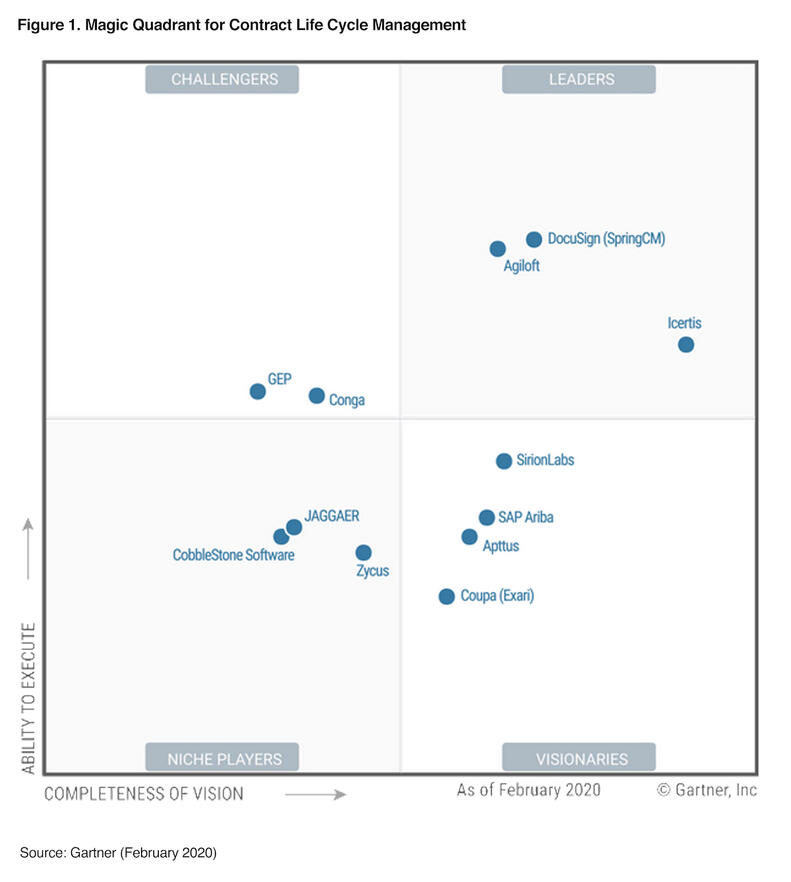DocuSign CLM Named a Leader in Gartner’s 2020 Magic Quadrant for Contract Lifecycle Management
DocuSign eSignature changed the way that many organizations execute a contract, but the contract lifecycle before and after signature is still often managed through manual processes—slowing the pace of doing business, increasing risk, and frustrating customers and employees.
Contract lifecycle management solutions address the entire contract process, automating manual tasks like document generation, orchestrating complex workflows and approval, and eliminating unnecessary risk. DocuSign’s contract lifecycle management offering, DocuSign CLM, is positioned as a Leader in the 2020 Gartner Magic Quadrant for Contract Lifecycle Management.
In this assessment, Gartner evaluated 12 CLM vendors based on 15 criteria including Offering (Product) Strategy, Market Responsiveness/Record, and Customer Experience. Docusign was positioned highest on the Ability to Execute Axis.
What is contract lifecycle management?
“The term “contract life cycle management” refers to applications used for managing contracts from initiation through ongoing management and eventual renewal or termination. CLM solutions manage any legal documents containing obligations that affect an organization.”, as defined by Gartner
Contract lifecycle management is a process of centralized contract management and storage. The purpose of contract lifecycle management software is to automate the process of managing contracts, as well as to offer a central place to store and retrieve contracts.
Contracts are used in every department, in organizations of every size and in every industry. Examples of the types of contracts that can be managed with a CLM solution include: purchase orders, sales contracts, loan documents, real estate lease agreements, employee offer letters, change orders, and non-disclosure agreements.
There are a number of recognized stages in the lifecycle of a contract. These can be simplified into the following: contract preparation, contract negotiation, contract signing, contract management, contract renewal, and sometimes contract closure.
By creating reusable templates, a library of terms, and repeatable, consistent conditions buyers and suppliers save time and reduce errors during the contracting process.
Contract management software is designed to
- Provide greater visibility into spend and commitments
- Save time by using templates and workflow
- Lower risk by allowing visibility into potential exposure
- Improve operational, contractual, and regulatory compliance
What to consider when evaluating a CLM solution
In this assessment, Gartner evaluated 12 CLM vendors based on 15 criteria including: Offering (Product) Strategy, Market Responsiveness/Record, and Customer Experience.
We believe, DocuSignCLM is positioned as a Leader because of customer experience scores and overall product capabilities.

This graphic was published by Gartner, Inc. as part of a larger research document and should be evaluated in the context of the entire document. The Gartner document is available upon request from DocuSign
Here are some core capabilities of contract management software:
- Flexible, configurable workflow. Organizations should be able to define, deploy and maintain contract workflows with ease—including workflows that involve other systems, such as electronic signature technologies or billing/payment systems. This means less dependence on upfront professional services, a faster path to value and lower total cost of ownership as contract processes change.
- Document generation. Ability to create preconfigured templates that auto-populate contracts with data from other systems and approved language. More advanced solutions offer an intuitive interface that empowers users and drives adoption.
- Support for collaboration and negotiation. The ability to send contracts for review, track changes across multiple versions, and maintain a single source of truth for who did what, when.
- Clause library. To reduce sales dependence on legal during negotiation, the best solutions offer the ability to create an easily accessible library of pre-approved clauses and fall-back options.
- Centralized searchable repository. Store, tag and organize all contracts in a single, searchable place, with permission controls.
- CRM integration. If you use Salesforce or another CRM system, you’ll want a CLM solution that integrates easily with your CRM so that agreements can be generated with CRM data, and once an agreement is signed, it can be pushed back to the CRM record.
- Security. Look for a solution that is compliant with SOC 2, HIPAA, TRUSTe, and FedRAMP.
Does my business need a CLM solution?
In today’s digital, on-demand world, CLM solutions help manage contract complexity as a business grows, as contract volumes increase, as stakeholders change and as more departments in the organization do business via contracts.
The more contracts and agreements your business has to manage, the more you would benefit from a CLM. If your business is large enough to have multiple departments managing contracts, you need a contract management solution.
Contract lifecycle management solutions are often part of digital transformation initiatives for sales, legal, and procurement teams because of the impact they can have on efficiency and customer experience. And because these solutions remove paper and ink, they support sustainability initiatives too.
Explore DocuSign CLM
See how Gartner positioned DocuSign CLM in the report. Download the full report, Gartner 2020 Magic Quadrant for Contract Lifecycle Management by Patrick Connaughton, Kaitlynn Sommers, Marko Sillanpaa, Micky Keck , 25 February 2020
Gartner does not endorse any vendor, product or service depicted in its research publications, and does not advise technology users to select only those vendors with the highest ratings or other designation. Gartner research publications consist of the opinions of Gartner’s research organization and should not be construed as statements of fact. Gartner disclaims all warranties, expressed or implied, with respect to this research, including any warranties of merchantability or fitness for a particular purpose.
GARTNER is a registered trademark and service mark of Gartner, Inc. and/or its affiliates in the U.S. and internationally, and is used herein with permission. All rights reserved.